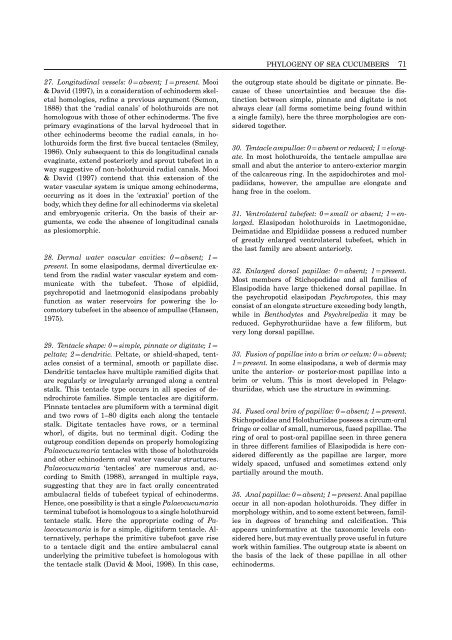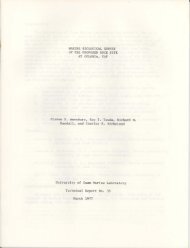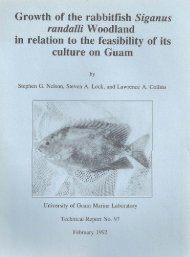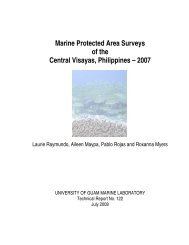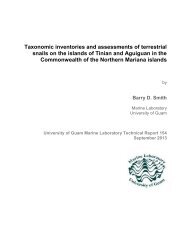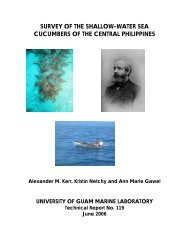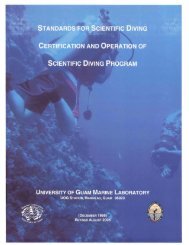Phylogeny of Holothuroidea (Echinodermata) inferred from ...
Phylogeny of Holothuroidea (Echinodermata) inferred from ...
Phylogeny of Holothuroidea (Echinodermata) inferred from ...
Create successful ePaper yourself
Turn your PDF publications into a flip-book with our unique Google optimized e-Paper software.
PHYLOGENY OF SEA CUCUMBERS 71<br />
27. Longitudinal vessels: 0=absent; 1=present. Mooi the outgroup state should be digitate or pinnate. Because<br />
<strong>of</strong> these uncertainties and because the dis-<br />
& David (1997), in a consideration <strong>of</strong> echinoderm skeletal<br />
homologies, refine a previous argument (Semon, tinction between simple, pinnate and digitate is not<br />
1888) that the ‘radial canals’ <strong>of</strong> holothuroids are not always clear (all forms sometime being found within<br />
homologous with those <strong>of</strong> other echinoderms. The five a single family), here the three morphologies are considered<br />
together.<br />
primary evaginations <strong>of</strong> the larval hydrocoel that in<br />
other echinoderms become the radial canals, in holothuroids<br />
form the first five buccal tentacles (Smiley,<br />
30. Tentacle ampullae: 0=absent or reduced; 1=elong-<br />
1986). Only subsequent to this do longitudinal canals<br />
ate. In most holothuroids, the tentacle ampullae are<br />
evaginate, extend posteriorly and sprout tubefeet in a<br />
small and abut the anterior to antero-exterior margin<br />
way suggestive <strong>of</strong> non-holothuroid radial canals. Mooi<br />
<strong>of</strong> the calcareous ring. In the aspidochirotes and mol-<br />
& David (1997) contend that this extension <strong>of</strong> the<br />
padiidans, however, the ampullae are elongate and<br />
water vascular system is unique among echinoderms,<br />
hang free in the coelom.<br />
occurring as it does in the ‘extraxial’ portion <strong>of</strong> the<br />
body, which they define for all echinoderms via skeletal<br />
and embryogenic criteria. On the basis <strong>of</strong> their ar- 31. Ventrolateral tubefeet: 0=small or absent; 1=enguments,<br />
we code the absence <strong>of</strong> longitudinal canals larged. Elasipodan holothuroids in Laetmogonidae,<br />
as plesiomorphic.<br />
Deimatidae and Elpidiidae possess a reduced number<br />
<strong>of</strong> greatly enlarged ventrolateral tubefeet, which in<br />
the last family are absent anteriorly.<br />
28. Dermal water vascular cavities: 0=absent; 1=<br />
present. In some elasipodans, dermal diverticulae ex-<br />
32. Enlarged dorsal papillae: 0=absent; 1=present.<br />
tend <strong>from</strong> the radial water vascular system and com-<br />
Most members <strong>of</strong> Stichopodidae and all families <strong>of</strong><br />
municate with the tubefeet. Those <strong>of</strong> elpidiid,<br />
Elasipodida have large thickened dorsal papillae. In<br />
psychropotid and laetmogonid elasipodans probably<br />
the psychropotid elasipodan Psychropotes, this may<br />
function as water reservoirs for powering the loconsist<br />
<strong>of</strong> an elongate structure exceeding body length,<br />
comotory tubefeet in the absence <strong>of</strong> ampullae (Hansen,<br />
while in Benthodytes and Psychrelpedia it may be<br />
1975).<br />
reduced. Gephyrothuriidae have a few filiform, but<br />
very long dorsal papillae.<br />
29. Tentacle shape: 0=simple, pinnate or digitate; 1=<br />
peltate; 2=dendritic. Peltate, or shield-shaped, tentacles<br />
consist <strong>of</strong> a terminal, smooth or papillate disc.<br />
Dendritic tentacles have multiple ramified digits that<br />
are regularly or irregularly arranged along a central<br />
stalk. This tentacle type occurs in all species <strong>of</strong> dendrochirote<br />
families. Simple tentacles are digitiform.<br />
Pinnate tentacles are plumiform with a terminal digit<br />
and two rows <strong>of</strong> 1–80 digits each along the tentacle<br />
stalk. Digitate tentacles have rows, or a terminal<br />
whorl, <strong>of</strong> digits, but no terminal digit. Coding the<br />
outgroup condition depends on properly homologizing<br />
Palaeocucumaria tentacles with those <strong>of</strong> holothuroids<br />
and other echinoderm oral water vascular structures.<br />
Palaeocucumaria ‘tentacles’ are numerous and, ac-<br />
cording to Smith (1988), arranged in multiple rays,<br />
suggesting that they are in fact orally concentrated<br />
ambulacral fields <strong>of</strong> tubefeet typical <strong>of</strong> echinoderms.<br />
Hence, one possibility is that a single Palaeocucumaria<br />
terminal tubefoot is homologous to a single holothuroid<br />
tentacle stalk. Here the appropriate coding <strong>of</strong> Palaeocucumaria<br />
is for a simple, digitiform tentacle. Alternatively,<br />
perhaps the primitive tubefoot gave rise<br />
to a tentacle digit and the entire ambulacral canal<br />
underlying the primitive tubefeet is homologous with<br />
the tentacle stalk (David & Mooi, 1998). In this case,<br />
33. Fusion <strong>of</strong> papillae into a brim or velum: 0=absent;<br />
1=present. In some elasipodans, a web <strong>of</strong> dermis may<br />
unite the anterior- or posterior-most papillae into a<br />
brim or velum. This is most developed in Pelago-<br />
thuriidae, which use the structure in swimming.<br />
34. Fused oral brim <strong>of</strong> papillae: 0=absent; 1=present.<br />
Stichopodidae and Holothuriidae possess a circum-oral<br />
fringe or collar <strong>of</strong> small, numerous, fused papillae. The<br />
ring <strong>of</strong> oral to post-oral papillae seen in three genera<br />
in three different families <strong>of</strong> Elasipodida is here considered<br />
differently as the papillae are larger, more<br />
widely spaced, unfused and sometimes extend only<br />
partially around the mouth.<br />
35. Anal papillae: 0=absent; 1=present. Anal papillae<br />
occur in all non-apodan holothuroids. They differ in<br />
morphology within, and to some extent between, famil-<br />
ies in degrees <strong>of</strong> branching and calcification. This<br />
appears uninformative at the taxonomic levels con-<br />
sidered here, but may eventually prove useful in future<br />
work within families. The outgroup state is absent on<br />
the basis <strong>of</strong> the lack <strong>of</strong> these papillae in all other<br />
echinoderms.


